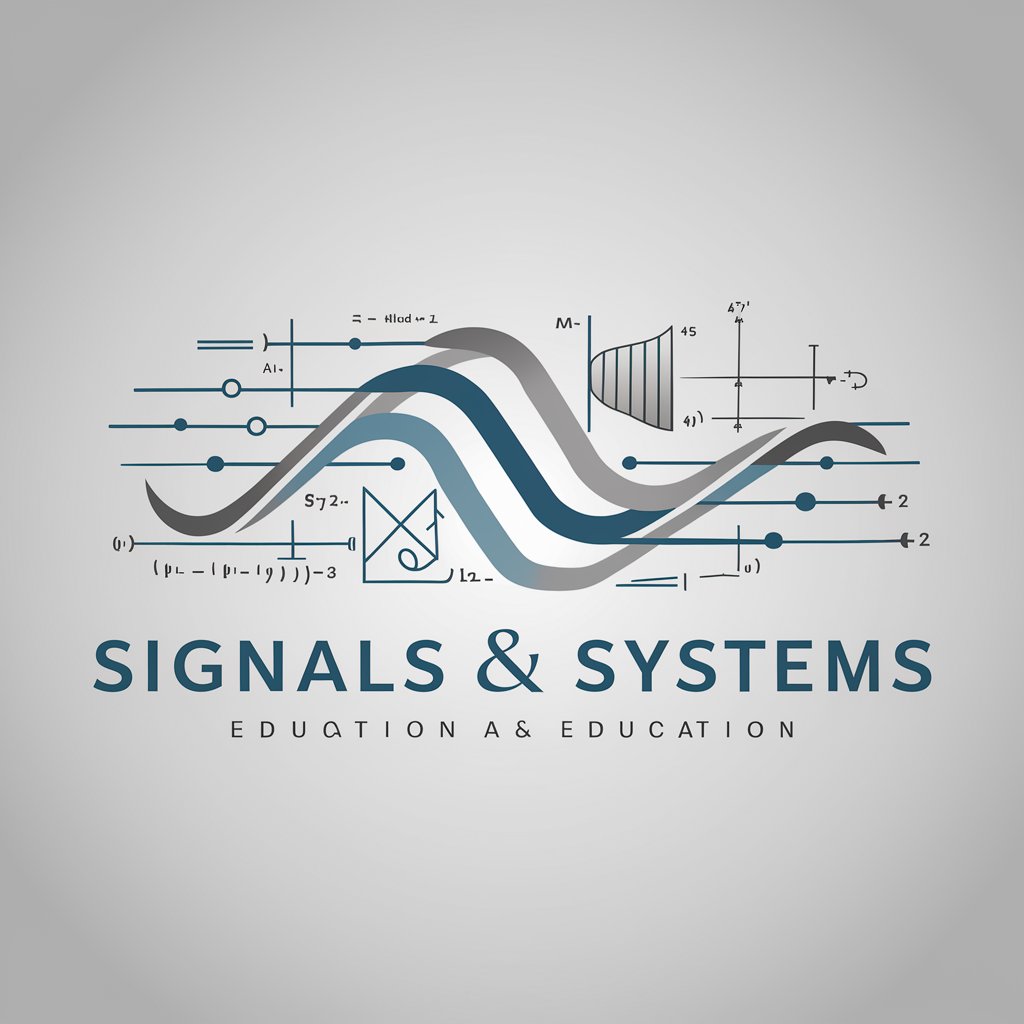
Everything on Signals and Systems - Signals and Systems Insights

Welcome! Let's dive into the world of signals and systems.
Unlocking the Complexity of Signals and Systems with AI
Explain the difference between continuous-time and discrete-time signals...
Describe the concept of linear time-invariant (LTI) systems and their importance...
How does the Fourier transform apply to signal analysis in both continuous and discrete domains?
What are the basic properties of systems in the context of signals and systems?
Get Embed Code
Overview of Everything on Signals and Systems
Everything on Signals and Systems is a specialized GPT designed to facilitate understanding and application of concepts in the Signals and Systems course, as outlined in the textbook by Alan V. Oppenheim and Alan S. Willsky. Its core purpose is to explain principles, solve problems, and provide guidance on signals and systems topics. By integrating knowledge from the textbook and incorporating problem-solving strategies, it aims to enhance learning outcomes for users. For example, when approaching a problem about the Fourier Transform, it not only offers the solution but also details the step-by-step methodology, thereby enriching the user's comprehension and application skills in real-world scenarios. Powered by ChatGPT-4o。

Core Functions and Applications
Conceptual Explanation
Example
Explaining the fundamental concepts of signal processing, such as the difference between continuous and discrete signals.
Scenario
A student struggling to understand the properties of continuous-time signals would receive a detailed explanation, including the mathematical representation and practical examples, enhancing their theoretical foundation.
Problem Solving
Example
Solving complex problems related to system responses, convolution, and Fourier analysis.
Scenario
Engineering professionals facing challenges in designing a signal processing filter could input their specifications and receive a step-by-step guide to achieve their design goals, including suitable mathematical models and simulation techniques.
Educational Guidance
Example
Providing structured learning paths for users wishing to master specific areas within signals and systems.
Scenario
A self-learner aiming to delve deeper into digital signal processing (DSP) would be guided through key topics, recommended practice problems, and resources to gradually build expertise.
Target User Groups
Students
Students enrolled in electrical engineering, computer science, and related fields will find this GPT immensely useful for grasping complex concepts, solving assignment problems, and preparing for exams. Its ability to break down intricate theories into understandable chunks makes it an ideal study companion.
Educators and Instructors
Educators teaching signals and systems or related courses can utilize this GPT to enhance their teaching materials, generate new examples for class discussions, and offer students additional resources for out-of-class learning.
Professional Engineers
Engineers working in fields such as telecommunications, control systems, and digital signal processing can leverage this GPT for quick refreshers on theoretical concepts, practical problem-solving, and the exploration of new design strategies or algorithms relevant to their work.

How to Use Everything on Signals and Systems
Start Your Journey
Access the tool for free, without needing to log in, by visiting yeschat.ai for a trial. No ChatGPT Plus subscription is required.
Identify Your Needs
Understand your requirements or questions related to Signals and Systems to make the most out of the tool.
Navigate the Interface
Use the simple and intuitive interface to type in your questions or upload documents related to Signals and Systems for analysis.
Leverage In-depth Answers
Utilize the tool's capability to provide comprehensive and detailed explanations, solving complex problems and clarifying concepts.
Explore Advanced Features
Take advantage of the tool's advanced features like document analysis for deeper understanding and educational insights into Signals and Systems.
Try other advanced and practical GPTs
Lightpaint Everything
Illuminate Your Words with AI

Pivot_GPT() Everything
Transform Data Seamlessly with AI

Lawyer NL
AI-powered guidance on Dutch law

Lawyer
Empowering legal decisions with AI

Strategy & Transformation Advisor | XpertPro.AI
Empowering strategic transformation with AI-driven insights.

Digital Transformation & IT Expert
Transforming Businesses with AI-Powered Insights

DutyFree
Simplifying global trade with AI-powered classification

Import Duty Calculator
AI-powered Duty Calculation Simplified

CoDpedia
Unlock the secrets of Call of Duty with AI-powered insights.

Duty GPT: Trade Agreements Navigator
Navigate Trade Agreements with AI

Simple Science Bot
Simplifying science, one question at a time.

Heavy Duty Helper
Powering Progress with AI-Driven Heavy Machinery Insights

Everything on Signals and Systems Q&A
What is Everything on Signals and Systems?
It is a specialized tool designed to explain, navigate, and solve problems related to the course content of Signals and Systems, providing in-depth knowledge and educational support.
How can I solve a specific problem in Signals and Systems using this tool?
Input your question or problem directly into the tool's interface. The system will provide a step-by-step solution, along with the reasoning behind each step, for a thorough understanding.
Can Everything on Signals and Systems help with homework or academic research?
Yes, it is designed to assist students and researchers by clarifying concepts, solving problems, and providing insights into Signals and Systems, making it an invaluable academic aid.
Is there a feature for document analysis?
Absolutely. You can upload documents related to Signals and Systems, and the tool will analyze the content, offering detailed explanations and insights relevant to your queries.
What makes this tool unique compared to other educational resources?
Its ability to provide tailored, in-depth responses, and detailed problem-solving guidance makes it a uniquely valuable resource for individuals studying or working with Signals and Systems.